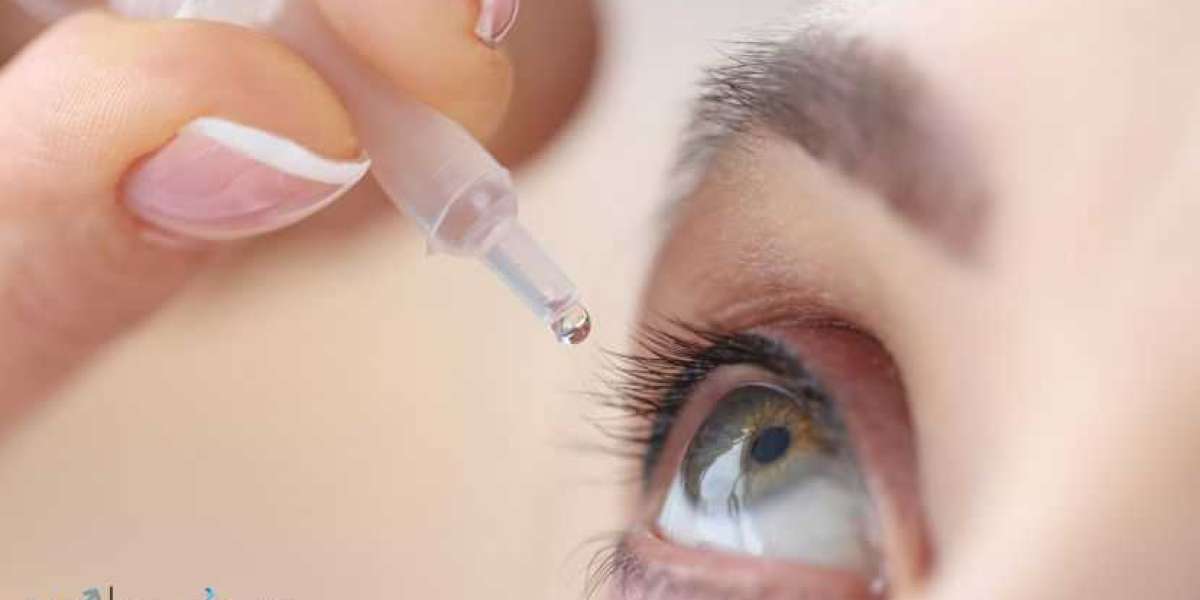Dry Eye Disease (DED) is a common ocular condition that affects millions of people worldwide, leading to discomfort, visual disturbance, and, in some cases, damage to the ocular surface. The market for dry eye disease treatments was valued at approximately USD 5.91 billion in 2024 and is expected to grow at a compound annual growth rate (CAGR) of 5.7% during the forecast period of 2025 to 2034. By the end of 2034, the market is projected to reach nearly USD 9.76 billion. This growth is driven by increasing awareness, advancements in treatment options, and a rising aging population that is more prone to dry eye disease.
Market Overview
Dry eye disease is a multifactorial disease of the ocular surface that causes symptoms such as eye irritation, discomfort, and redness. It can be caused by a variety of factors, including insufficient tear production, excessive evaporation of tears, or inflammation of the ocular surface. Treatments for dry eye disease range from over-the-counter artificial tears to prescription medications and surgical interventions. With a significant global population affected by this condition, the market for dry eye treatments continues to expand as more effective solutions are developed. As the prevalence of dry eye disease rises and the variety of available treatments increases, the market is experiencing steady growth, benefiting both pharmaceutical companies and healthcare providers.
Market Size and Share
The dry eye disease treatment market is projected to reach USD 9.76 billion by 2034, growing from a value of USD 5.91 billion in 2024. This growth reflects a CAGR of 5.7% from 2025 to 2034. The market size is significantly influenced by the rising prevalence of dry eye disease, particularly among aging populations. Additionally, improvements in diagnostic tools and the introduction of innovative treatments, such as biologics and advanced ocular devices, are expected to contribute to market expansion. The increasing awareness of the condition and its treatments, along with enhanced patient access to care, will also play a key role in driving market growth.
Market Trends
- Rising Incidence of Dry Eye Disease
The increasing prevalence of dry eye disease, especially among older adults, is a significant market driver. As the global population ages, the number of individuals suffering from age-related eye conditions, including dry eye disease, is growing. Additionally, environmental factors such as air pollution and prolonged screen time have increased the number of people at risk, further fueling the demand for effective treatments. - Technological Advancements in Treatment
Technological advancements in dry eye disease treatment, such as the development of novel biologics and device-based therapies, are transforming the market. For example, liposomal sprays and thermal pulsation treatments have shown promising results in managing the condition. These innovations offer patients more targeted and effective solutions, improving both symptoms and quality of life, which drives market demand. - Increased Focus on Personalized Medicine
Personalized medicine is becoming an emerging trend in the dry eye disease treatment market. Tailored treatments based on individual patient profiles, such as those that target specific underlying causes of dry eye disease, are gaining popularity. This approach enhances treatment effectiveness and patient satisfaction, which is expected to contribute significantly to the market’s growth. - Expansion of Online Pharmacies
The growing role of online pharmacies in distributing dry eye disease treatments is changing how patients access their medications. With the rise of e-commerce, patients can easily order artificial tears, prescription medications, and other dry eye treatments from the comfort of their homes. This trend is expected to continue, making treatments more accessible and convenient, especially for individuals in rural or underserved areas.
Market Analysis
- Product Segmentation
The dry eye disease treatment market is segmented into various product types, including artificial tears, anti-inflammatory drugs, punctal plugs, secretagogues, and others. Artificial tears hold the largest market share due to their widespread availability and effectiveness in providing relief for mild to moderate dry eye symptoms. Anti-inflammatory drugs, such as cyclosporine A and corticosteroids, are gaining popularity for treating moderate to severe cases of dry eye disease. Punctal plugs are often used for patients with persistent symptoms and offer a more long-term solution. - Distribution Channel Segmentation
The market is also segmented by distribution channels, including hospital pharmacies, independent pharmacies and drug stores, and online pharmacies. Hospital pharmacies are expected to hold a significant share, particularly for prescription treatments and specialized therapies. However, online pharmacies are witnessing rapid growth due to the increasing shift toward e-commerce and the convenience they offer for purchasing over-the-counter products. - Regional Insights
The dry eye disease treatment market is geographically segmented into North America, Europe, Asia Pacific, Latin America, and the Middle East Africa. North America holds the largest market share, driven by a large aging population and high healthcare expenditure. The Asia Pacific region is expected to experience the fastest growth due to rising awareness, improving healthcare infrastructure, and increasing adoption of advanced treatment options. - Breakup by Product
Artificial tears are the dominant product segment in the market, accounting for the largest share. These over-the-counter products are essential for providing immediate relief from the discomfort of dry eyes. Anti-inflammatory drugs and punctal plugs follow, with secretagogues, such as pilocarpine, being used as a secondary treatment for more severe cases. Other treatments, including surgical options and devices, also contribute to the market.
Regional Insights
- North America
North America is the largest market for dry eye disease treatments, largely due to a high incidence of dry eye disease, especially among aging populations in the United States and Canada. Additionally, the presence of major pharmaceutical companies, advancements in treatment options, and strong healthcare infrastructure contribute to the region’s dominance. Increased consumer awareness and availability of a wide range of treatment options further enhance the market’s growth. - Asia Pacific
The Asia Pacific region is witnessing the fastest growth in the dry eye disease treatment market. Rising awareness about dry eye disease, coupled with improvements in healthcare infrastructure, are key factors contributing to the market's expansion in countries like China, Japan, and India. The growing adoption of advanced treatment methods, along with a large patient base, presents significant opportunities for market players in this region.
Market Growth
Several factors are driving the growth of the dry eye disease treatment market. The global aging population is one of the primary drivers, as older individuals are more prone to developing dry eye disease. Additionally, lifestyle factors such as increased screen time and exposure to environmental pollutants have heightened the prevalence of the condition. Moreover, ongoing innovations in drug development and device-based therapies are providing more effective treatments, further accelerating market growth. The increasing availability of treatments via online pharmacies and the expanding healthcare infrastructure in emerging markets also contribute to market expansion.
Get a Free Sample Report with a Table of Contents
Recent Developments Challenges
- Advancements in Drug Development
Recent advancements in drug development, particularly in biologics and anti-inflammatory treatments, are transforming the dry eye disease treatment landscape. New drug formulations that target the underlying causes of dry eye disease are providing patients with more effective options. For example, the approval of lifitegrast (Xiidra) has added a novel drug option for patients with moderate to severe dry eye disease. - Regulatory Approvals
Regulatory approvals for new treatments are critical for market growth. The FDA's approval of new therapies, such as cyclosporine A (Restasis), has provided a broader range of options for patients. Additionally, the increasing focus on personalized treatment options is paving the way for more tailored therapies that can address specific causes of dry eye disease. - Emerging Market Growth
Emerging markets, particularly in Asia and Latin America, are seeing an increasing demand for dry eye treatments as awareness of the condition grows. The expansion of healthcare infrastructure and rising incomes in these regions are facilitating market growth. However, affordability remains a challenge in some areas, which may hinder growth in the short term. - Challenges with Treatment Adherence
One of the ongoing challenges in the dry eye disease treatment market is treatment adherence. Many patients struggle with consistently using prescribed treatments, especially those that involve multiple daily applications. Improving patient education and developing more convenient treatment options may help address this challenge.
Key Players
AbbVie Inc.
AbbVie Inc. is a global biopharmaceutical company and one of the leading players in the dry eye disease treatment market. AbbVie’s product portfolio includes Restasis, a prescription drug designed to treat dry eye disease by reducing inflammation and increasing tear production. The company's strong research and development capabilities and commitment to addressing unmet needs in eye care contribute to its leadership position in the market.
Bausch and Lomb Incorporated
Bausch and Lomb, a division of Bausch Health Companies, is another key player in the dry eye disease treatment market. The company offers a variety of treatments, including artificial tears, lubricating eye drops, and prescription therapies. Its comprehensive product line and focus on innovation make Bausch and Lomb a significant player in the global eye care market.
Johnson Johnson Services, Inc.
Johnson Johnson Services, Inc. is a well-known name in the pharmaceutical and healthcare industry. The company’s eye care division provides a range of treatments for dry eye disease, including artificial tears and anti-inflammatory products. Its reputation for innovation and global reach ensures its continued success in the dry eye treatment market.
Santen Pharmaceutical Co., Ltd
Santen Pharmaceutical Co., Ltd is a leading player in the ophthalmology market, with a strong focus on treating dry eye disease. The company offers a range of prescription and over-the-counter products, including ophthalmic solutions and anti-inflammatory medications. Santen's commitment to advancing eye care treatments positions it as a major player in the market.
Other Companies operating in the dry eye disease treatment market include OASIS Medical, Novartis AG, Allergan, and Pfizer, among others.
FAQs
What is dry eye disease?
Dry eye disease is a condition where the eyes do not produce enough tears or the quality of tears is insufficient to keep the eyes lubricated. It leads to symptoms such as dryness, irritation, and discomfort.
What are the main treatments for dry eye disease?
Treatments for dry eye disease include artificial tears, anti-inflammatory drugs, punctal plugs, and secretagogues. In some cases, surgical interventions may be required.
Which factors contribute to the growth of the dry eye disease treatment market?
The growth is driven by factors such as the increasing prevalence of dry eye disease, technological advancements in treatment options, an aging population, and rising awareness about the condition.
What is the forecast for the dry eye disease treatment market?
The dry eye disease treatment market is expected to grow at a CAGR of 5.7% from 2025 to 2034, reaching nearly USD 9.76 billion by the end of the forecast period.
Read Our Blogs
Global Vessel Sealing Device Market: Top 9 Leading Providers Innovations






